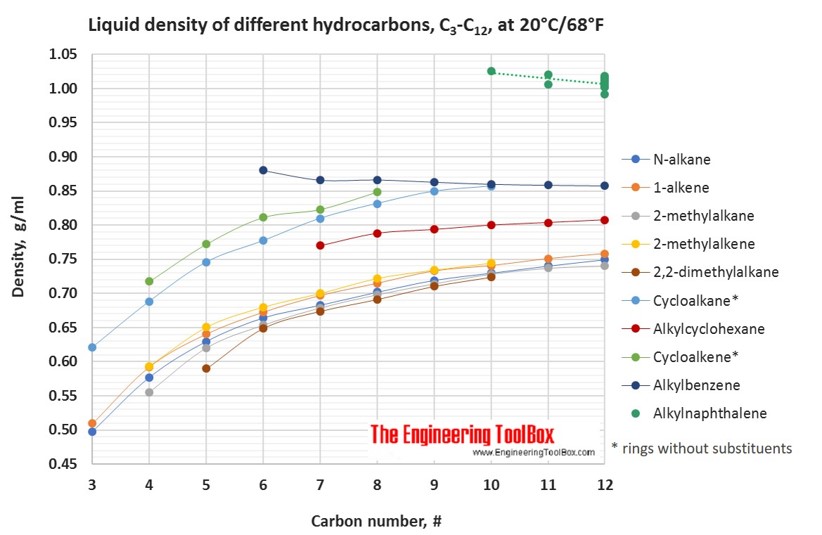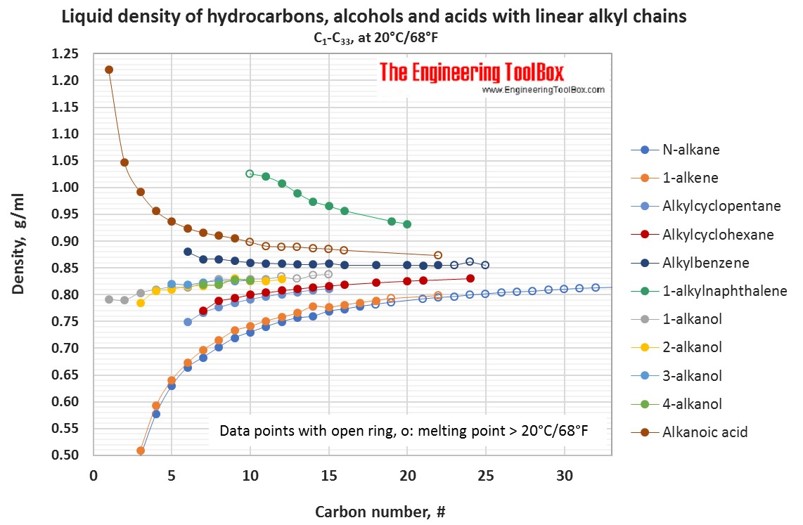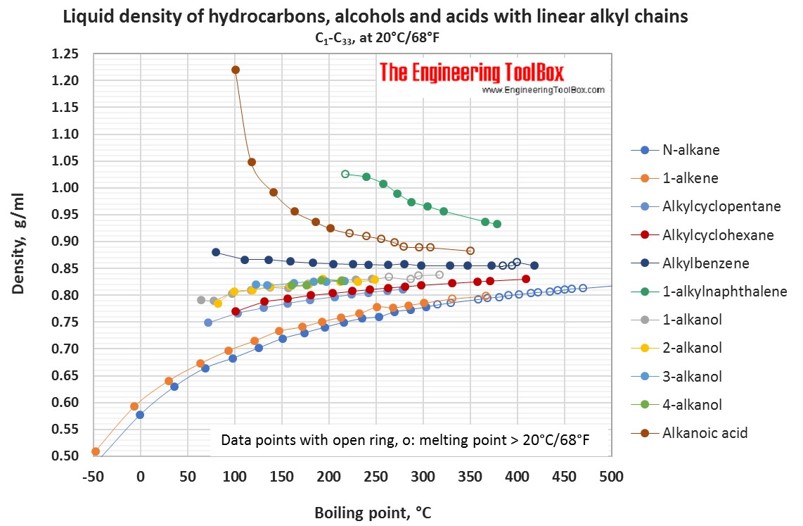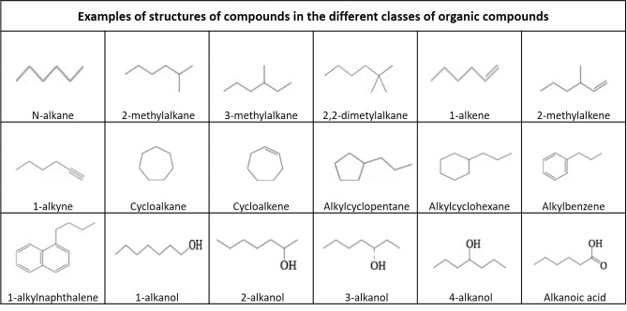Hydrocarbons, Linear Alcohols and Acids - Densities (original) (raw)
The tables and figures below show how the liquid density at 20°C (68°F) changes with increasing carbon number up to C33 for different hydrocarbons . The densities are also shown as function of boiling point of the hydrocarbons. Definitions and examples of molecular structures of the different classes of organic compounds are given below the figures.
See also boiling and melting point of the same compounds, densities of organic sulfur compounds and density, boiling and melting points of nitrogen and sulfur compounds.
See long list of hydrocarbons - physical data, including molweight, melting and boiling point, density, flash point and autoignition temperature, as well as number of carbon and hydrogen atoms.



For hydrocarbons with melting point > 20°C, the liquid density at 20°C is extrapolated from density measurements just above the above melting point.
For full table - rotate the screen!
Hydrocarbons, Linear Alcohols and Acids - Densities
| Carbon number | Liquid density of hydrocarbons, alcohols and acids, C1-C16, at 20°C/68°F | |||||||||||||||
|---|---|---|---|---|---|---|---|---|---|---|---|---|---|---|---|---|
| 1 | 2 | 3 | 4 | 5 | 6 | 7 | 8 | 9 | 10 | 11 | 12 | 13 | 14 | 15 | 16 | |
| 2,2-dimetylalkane | 0.590 | 0.648 | 0.674 | 0.691 | 0.711 | 0.724 | ||||||||||
| 2-methylalkane | 0.556 | 0.620 | 0.654 | 0.679 | 0.698 | 0.714 | 0.728 | 0.737 | 0.740 | |||||||
| N-alkane | 0.498 | 0.577 | 0.630 | 0.664 | 0.683 | 0.702 | 0.719 | 0.730 | 0.740 | 0.750 | 0.756 | 0.760 | 0.769 | 0.773 | ||
| 3-methylalkane | 0.660 | 0.687 | 0.705 | 0.720 | 0.735 | 0.742 | 0.7489 | |||||||||
| 1-alkene | 0.510 | 0.593 | 0.641 | 0.673 | 0.697 | 0.715 | 0.733 | 0.741 | 0.751 | 0.758 | 0.766 | 0.779 | 0.776 | 0.781 | ||
| 2-methylalkene | 0.594 | 0.650 | 0.680 | 0.700 | 0.722 | 0.734 | 0.744 | |||||||||
| 1-alkyne | 0.611 | 0.683 | 0.690 | 0.719 | 0.733 | 0.746 | 0.766 | 0.766 | 0.773 | 0.779 | 0.784 | 0.790 | 0.794 | 0.796 | ||
| Alkylcyclopentane | 0.749 | 0.767 | 0.776 | 0.785 | 0.791 | 0.797 | 0.801 | 0.805 | 0.808 | 0.811 | ||||||
| Alkylcyclohexane* | 0.770 | 0.788 | 0.794 | 0.800 | 0.804 | 0.808 | 0.811 | 0.814 | 0.816 | 0.819 | ||||||
| Cycloalkane** | 0.621 | 0.688 | 0.746 | 0.777 | 0.810 | 0.831 | 0.849 | 0.857 | ||||||||
| 2-alkanol | 0.785 | 0.806 | 0.809 | 0.816 | 0.817 | 0.819 | 0.830 | 0.825 | 0.825 | 0.829 | ||||||
| 4-alkanol | 0.818 | 0.819 | 0.828 | 0.826 | ||||||||||||
| 1-alkanol | 0.791 | 0.789 | 0.804 | 0.810 | 0.814 | 0.814 | 0.822 | 0.829 | 0.828 | 0.830 | 0.830 | 0.833 | 0.830 | 0.836 | 0.838 | |
| 3-alkanol | 0.820 | 0.818 | 0.823 | 0.826 | 0.825 | 0.827 | 0.088 | 0.829 | ||||||||
| Cycloalkene** | 0.718 | 0.772 | 0.811 | 0.823 | 0.848 | |||||||||||
| Alkylbenzene* | 0.880 | 0.866 | 0.866 | 0.863 | 0.860 | 0.859 | 0.858 | 0.857 | 0.856 | 0.858 | 0.855 | |||||
| Alkanoic acid | 1.220 | 1.048 | 0.991 | 0.956 | 0.937 | 0.924 | 0.916 | 0.910 | 0.905 | 0.898 | 0.891 | 0.889 | 0.889 | 0.887 | 0.885 | 0.883 |
| 1-alkylnaphthalene | 1.025 | 1.020 | 1.008 | 0.990 | 0.974 | 0.966 | 0.957 | |||||||||
| * C#(N-alkyl)=0-10 | ||||||||||||||||
| ** rings without substituents |


Definitions of organic compounds
Hydrocarbon: An organic compound consisting entirely of hydrogen and carbon.
Main groups of hydrocarbons:
Alkane: An acyclic saturated hydrocarbon, with the general formula CnH2n+2. Also called paraffin.
Alkene: An unsaturated hydrocarbon that contains at least one carbon–carbon double bond, with the general formula CnH2n. Also called olefine.
Alkyne: An unsaturated hydrocarbon containing at least one carbon—carbon triple bond, with the general formula CnH2n-2. Also called acetylene.
Cycloalkane: A one-ring (monocyclic) saturated hydrocarbon, with the general formula CnH2n. Also called naphthene.
Cycloalkene: An alkene hydrocarbon which contains a closed ring of carbon atoms, but has no aromatic character, with the general formula CnH2n-2. Also called cycloolefin.
Aromatic hydrocarbon: A cyclic (ring-shaped), planar (flat) molecule with a ring of resonance bonds that exhibits more stability than other geometric or connective arrangements with the same set of atoms. The simplest of the aromatics have 6 carbon atoms and contains 3 double bounds. A one ring aromatic without any substituents is called benzene, with the formula C6H6.
Polycyclic aromatic hydrocarbons: hydrocarbon that are composed of multiple aromatic rings. A two ring aromatic without any substituents is called naphthalene, with the formula C10H8.
Some under-groups of hydrocarbons given in this document:
Alkyl: An alkane substituent missing one hydrogen, with general formula CnH2n+1
2-Methylalkane: A branched alkane, with a methyl group connected to the second carbon atom in the main carbon chain.
3-Methylalkane: A branched alkane, with a methyl group connected to the third carbon atom in the main carbon chain.
2-Methylalkene: A branched alkene, with a methyl group connected to the second carbon atom in the main carbon chain.
Alkylcycklohexane: A monosubstituted cyclohexane with one branching via the attachment of one alkyl group on one carbon of the cyclohexane ring, with the general formula CnH(2n+1)C6H11.
Alkylcycklopentane: A monosubstituted cyclopentane with one branching via the attachment of one alkyl group on one carbon of the cyclohexane ring, with the general formula CnH2n+1C5H9.
Alkylbenzene: A monosubstituted benzene with one branching via the attachment of one alkyl group on one carbon of the benzene ring, with the general formula CnH(2n+1)C6H5.
Alkylnaphthalene: A monosubstituted naphthalene with one branching via the attachment of one alkyl group on one carbon of one of the aromatic rings, with the general formula CnH(2n+1)C10H7.
Some other groups of organic compounds:
Alcohol: an organic compound in which the hydroxyl functional group (–OH) is bound to a saturated carbon atom
Alkanol: An alcohol where the hydroxyl group is connected to an alkane
Carboxylic acid: an organic compound that contains a carboxyl group (C(=O)OH). The general formula of a carboxylic acid is R–COOH, with R referring to the rest of the molecule.
Alkanoic acid: A carboxylic acid where the R is an alkane.
Molweight, melting and boiling point, density, pKa-values, as well as number of carbon and hydrogen atoms in molecules are given for 150 different alcohols and acids.
API expresses the gravity or density of liquid petroleum products. Online API to Specific Gravity calculator.
Online calculator, figures and table showing density and specific weight of benzene, C6H6, at temperatures ranging from 5 to 325 °C (42 to 620 °F) at atmospheric and higher pressure - Imperial and SI Units.
Chemical, physical and thermal properties of benzene, also called benzol. Phase diagram included.
Variations in crude oil density are shown as function of temperatur, together with volume correction factors.
An overview of common test methods and typical ranges of variation of petroleum quality parameters. What, why and how do the different test?
Changes in density of aqueous solutions with changes in concentration at 20°C. Density of inorganic chlorides in water is plotted as function of wt%, mol/kg water and mol/l solution.
Changes in density of aqueous solutions with changes in concentration at 20°C. Density of potassium salts in water is plotted as function of wt%, mol/kg water and mol/l solution.
Changes in density of aqueous solutions with changes in concentration at 20°C. Density of inorganic sodium salts in water is plotted as function of wt%, mol/kg water and mol/l solution.
Changes in density of aqueous solutions with changes in concentration at 20°C. Density of acetic acid, citric acid, formic acid, D-lactic acid, oxalic acid and trichloroacetic acid in water is plotted as function of wt%, mol/kg water and mol/l solution.
Online density converter with commonly used units.
Changes in density of aqueous solutions with changes in concentration at 20°C. Density of some sugars, alcohols and other organic substances in water is plotted as function of wt%, mol/kg water and mol/l solution.
Changes in density of aqueous solutions with changes in concentration at 20°C. Density of inorganic substances in water is plotted as function of wt%, mol/kg water and mol/l solution.
An introduction to density, specific weight and specific gravity.
The elements of the periodic system with names, symbols, atomic numbers and weights, melting and boiling points, density, electronegativity and electron affinity, and electron configuration.
Online calculator, figures and tables showing dynamic and kinematic viscosity of ethanol, C2H5OH, at varying temperature and pressure - Imperial and SI Units.
Online calculator, figures and tables showing density and specific weight of ethanol at temperatures ranging from -25 to 325 °C (-10 to 620 °F) at atmospheric and higher pressure - Imperial and SI Units.
Variations in fuel oils density as function of temperatur, together with volume correction factors.
Molweight, melting and boiling point, density, flash point and autoignition temperature, as well as number of carbon and hydrogen atoms in each molecule for 200 different hydrocarbons.
Variations in jet fuel density as function of temperatur, together with volume correction factors.
It is possible to estimate the density of a liquid-liquid solution from the density of the solute and the solvent. However, due to shrinkage, the estimate will be a bit too low.
Densities of common liquids like acetone, beer, oil, water and more.
Densities and specific volume of liquids vs. pressure and temperature change.
Specific gravities of liquids like alcohol, oils, benzene, water and many more.
Variations in lubricating oil density as function of temperatur, together with volume correction factors.
Melting temperature (°C and °F) with carbon number up to C33.
Online calculator, figures and tables showing dynamic and kinematic viscosity of methane, CH4, at varying temperature and pressure - Imperial and SI Units.
Online calculator, figures and tables showing dynamic and kinematic viscosity of liquid methanol,CH3OH, at varying temperature - Imperial and SI Units.
Liquid density of different kinds of organic sulfur compounds with varying carbon number (20°C/68°F). Comparison of thiols, sulfides, disulfides and thiophenes.
Online calculator, figures and table showing density and specific weight of pentane, C5H12, at temperatures ranging from -130 to 325 °C (-200 to 620 °F) at atmospheric and higher pressure - Imperial and SI Units.
Definition, explanation and examples of calculation of various types of average boiling point of petroleum products and other mixtures of hydrocarbons: VABP, MABP, WABP, CABP and MeABP.
An overview of common test methods and specifications of petroleum fuels. What, why and how do the different test?
For oxygen containing organic compounds this is given: pKa (the negative logarithm of the acid dissociation constant), molecular structures, molar weights, density and melting and boiling points.
Densities of selected solids.
Definitions and examples of how to calculate wt%, molarity and how to prepare dilutions.
Online calculator, figures and tables showing Specific Volume of water at temperatures ranging from 0-370 °C and 32 - 700 °F - Imperial and IS Units.
Yields of different crude oil distillation cuts are plotted as function of whole crude specific gravity. Fractions based on European and North American markets, and the typical differences in crude oil fractionation in the two markets are also shown.